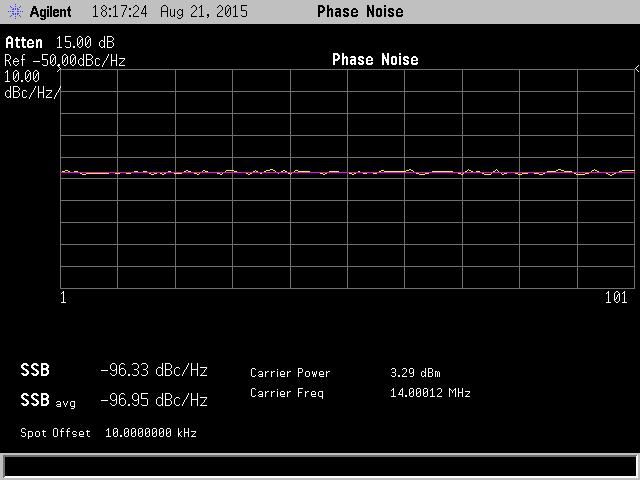There has been some discussion on various forums, and the comments sections of a number of Ham Blogs and on-air QSOs, concerning the Phase Noise of the Si5351 chip being offered in the form of breakout boards.
I recently commented on a post that Bill Meara, N2CQR, put on his SolderSmoke Daily News Blog. I was thinking about both sides of the argument and since I had an SA with a Phase Noise personality, I figured I’d do the measurements.
Not a bad raw view at a RBW of 300 Hz. The baseline is at -80 dBm with phase noise seen near the carrier at -60 dBm.
Next is the Phase Noise measurement trace. As you can see, the average SSB phase noise came out to -96.95 dBc/Hz.
Lastly, and probably more telling, was the THD measurement of the carrier and 9 harmonics.
As can be seen above, the notable issue is the THD being 40.67%. However, any low-pass function prior to mixing stages will adequately block most of this harmonic content above 14 Mhz and is a frequent feature of modern superheterodyne architectures.
So while the Phase Noise measurement was not bad at all, the real concern when using what was intended to be a multi-clock generator chip for use in digital systems, is to get the THD down coming into a mixer stage (and after of course) so that the result is closer to a more pure sine wave.



With a square wave output I would have thought that it is ideal for the LO in any TCVR project. After all, the LO is used to switch the mixer diodes (transistors in active mixers), so even if you filter the LO to be a pure sine-wave, the switching action of the mixers converts it back to a square wave anyway.
On the RF port it is another matter, but for the LO it is my belief that a square wave is ideal.
I’m looking at using something like an Si5351 as a signal source to replace the crystal oscillators in a amateur radio repeater. Maybe driving the chip with a PIC or other processor, and building up a “black box” that is USB programmed (once) and has a +12 input and a RF output that feeds the existing receiver or transmitter.
Both Motorola and GE have used a packaged TCXO over the years… GEs trademark was the ICOM – Integrated Circuit Oscillator Module, Moto used the term “Channel Element”. GEs radios operated on the fundamental, Moto used the fundamental in some radios and the 3rd harmonic on other product lines. The transmitter TCXOs had a modulation input that drove a varactor diode.
My mythical “black box” would plug into the radio in place of the TCXO module. Or if it’s a dual output lack box then there would be two cables with one plugging into the receiver TCXO position and the other to the transmitter TCXO position.
The receiver is easier than the transmitter… if you want to listen to, for example, 146.52 using a 11.7 MHz IF frequency the injection has to happen at 158.22 MHz and divide by 12… giving 13.185 MHz. To replace the stock crystal you just generate a clean, steady signal on 13.185 MHz at the correct level… Or if the radio used the tripled output of the TCXO then the radio was looking for 39.555 MHz and multiplied by 4.
The transmitter issue is that it’s difficult to FM modulate a DDS in such a way that you can’t tell the difference between a stock crystal based TCXO and the Si5351.
Using our 146.52 example you would just generate 12.21 MHz and the +/- 5KHz modulator would take it up to 12,210,416.666… Hz on positive modulation peaks and down to 12,209,583.333… Hz on negative modulation peaks. Or the tripled output if the particular radio wanted that.
Any ideas on how to get the Si5351 (or some other chip?) to produce a clean and stable FM modulated signal that is as clean as a Moto or GE TCXO ?
Thanks for listening
Mike WA6ILQ
The problem you describe is essential the same one that was faced by designers of synthesized signal generators to produce an FM modulated output without the varactor/XO circuit of the past. Here is one example application note that shows one solution:
Click to access AN-543.pdf
Another approach is to use the circuit design employed in GPS disciplined oscillators. This is essentially a TCXO/varactor circuit that is ‘disciplined’ by calculating (in hardware) the difference between the GPS Pulse Per Second and a fixed division of the oscillator output to arrive at an error voltage that is used to shift the output frequency by leveraging the varactor diode. It might be possible to modulate this GPS locked carrier in the same way the TCXO’s you mentioned were. To pursue this line of thought, I would join the Time Nuts list group and post the question to the geniuses that frequent that list. You might also find such a question was already asked by searching the archives. http://www.leapsecond.com/time-nuts.htm
Russ
K0WFS
Hi Russ, any other measurements that can be used to compare the numbers? The numbers look great but it will help if we can compare it to something like…… AD9851 for example, or a crystal oscillator. Thanks for your insight.
Ketut YB9BWN
Ketut, the phase noise @ 10 kHz offset of many DDS chips is much better than the Si5351, for example, the AD9851 is about -142 dBc. TCXO’s also exceed the phase noise measurements of the Si5351. While the numbers are better, in many cases the Si5351 is still a good choice.